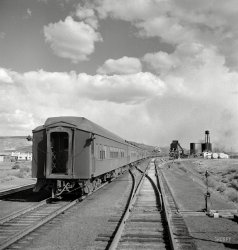
MAY CONTAIN NUTS

Search Shorpy
SHORPY ART

Framed or unframed, desk size to sofa size, printed by us in Arizona and Alabama since 2007. Explore now.
Join and Share
Ad-Free Shorpy
Shorpy is funded by you. Patreon contributors get an ad-free experience.
Learn more.

Recent comments
- Recent view
- Hudson’s Big Store
- Say what??
- Grapes?!
- A Beautiful Moment
- Such joy
- Bethune-Cookman University today...
- Yellow sky at morning
- Side Winder
- Air Quality?
- Sojourner Truth riot
- None were so blind(ed)
- The less famous sister
- Good ol' days?
- Rise and Fall
- Goo Goo Ga Joob
- Ticket Retention
- Not the only one
- Vagaries of War
- Killed by Amtrak
- Back to the Future
- Wanted --
- If you can't stand the light
- Centralized Traffic Control, I believe
- What's really happening
- Heckuva remote control!
- Sometimes — Things Go Bump!
- I SEE THE LIGHT
- Union Switch and Signal Company
- Get That Light Out Of My Eyes
Member Photos
The Shorpy
Print Emporium
Print Emporium
Search Shorpy
Search results -- 30 results per page
- Durward Nickerson: 1914
- ... Graham Weaver. Durward died in 1937 in Bernalillo County, New Mexico, at the age of 42.
Patsy Weaver
[Oh my. What happened? Did ... Posted by Dave - 08/26/2011 - 3:49pm -
![Durward Nickerson: 1914 "Durward Nickerson, Western Union messenger #55. Birmingham, Alabama. 18 years old. Lives in Bessemer, R.F.D. #1. Saturday night, Sept. 26, 1914, he took investigator through the old Red Light on Avenue A, pointed out the various resorts, told about the inmates he has known there. Only a half dozen of them were open now. Durward has put in two years in messenger work and shows the results of temptations open to him. He has recently returned from a hobo trip through 25 states. He was not inclined to tell much about the shady side of messenger work, but one could easily see that he has been through much that he might have avoided in a profitable kind of work." View full size. Photo by Lewis Wickes Hine.
Lewis HineLewis Wickes Hine: Photographer, social reformer and busybody party-pooper extraordinaire.
Shady workI had no idea messenger work could be so seedy.
LisaHe looks old beyond his years. Great idea for a blog. I subscribed to your feed.
Durward NickersonDurward M. Nickerson was the son of Otis Graham Nickerson & Hattie E. Shepard, great-grandparents of my husband, Jack Graham Weaver. Durward died in 1937 in Bernalillo County, New Mexico, at the age of 42.
Patsy Weaver
[Oh my. What happened? Did he leave a family? Thanks for the info. He seems like a dashing young man. - Dave]
(The Gallery, Birmingham, Lewis Hine)](https://www.shorpy.com/files/images/03932u_1.thumbnail.jpg)
- South by Southwest: 1943
- March 1943. Melrose, New Mexico. Chicago to California trip. "Santa Fe R.R. train." View full ... Posted by Dave - 08/10/2012 - 7:50pm -
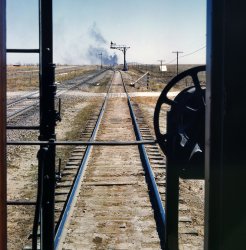
- Flapper's Up: 1920
- ... a seven-year convalescence at a tuberculosis sanatorium in New Mexico, while Marjorie was in Washington D.C. petitioning (unsuccessfully) ... Posted by Dave - 07/07/2015 - 6:09pm -
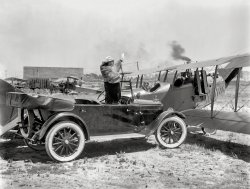
- Squat-N-Gobble: 1940
- September 1940. "Men of the community of Pie Town, New Mexico, eating at the barbeque." Kodachrome transparency by Russell Lee. ... Posted by Dave - 09/07/2011 - 5:16pm -
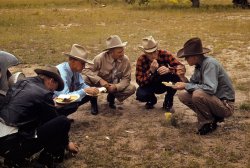
- Little Oklahoma: 1939
- ... station run by former resident of Oklahoma in Questa, New Mexico. Oklahoma newspapers as well as other Oklahoma products are for sale ... Posted by Dave - 06/15/2018 - 12:55pm -
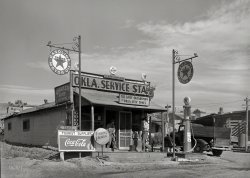
- Color Field: 1943
- ... March 1943. "A Southern Pacific freight passing Vaughn, New Mexico. The Santa Fe R.R. crosses the Southern Pacific R.R. at Vaughn." 4x3 ... Posted by Dave - 04/14/2017 - 10:14pm -
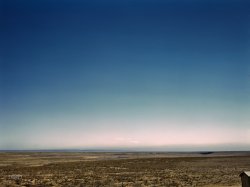
- Snappy Lunch: 1940
- June 1940. "Main street of Mogollon, New Mexico. Second largest gold section in the state." Photo by Russell Lee for ... Posted by Dave - 08/15/2018 - 1:38pm -
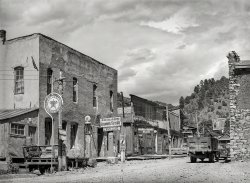
- Red Ryder: 1940
- ... Christi, Texas. "Small boy, son of carpenter from Hobbs, New Mexico, reading funny papers in corner of room in tourist court. Lack of ... Posted by Dave - 09/19/2018 - 12:31pm -
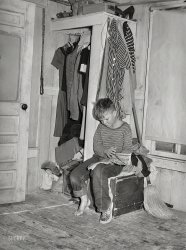
- Mystery 50s photo
- ... I'm pretty sure the Packard's license plate is not from New Mexico or Utah. It has an early 1950s California look to it. The color ... Posted by Lady Ashmire - 08/17/2012 - 8:14pm -
![Mystery 50s photo Judging from the other photos in the box with this, these people are either relatives or childhood/family friends of my mother, which would mean the pic was most likely taken in Salt Lake City or possibly Albuquerque, those being the two cities where she grew up. Unfortunately, those who would know for sure are no longer alive to tell me. I just found it an interesting pic, as you don't seem to see photos of less-prosperous-looking people in this time period very often, also I thought some Shorpyites might have fun trying to identify the various vehicles in the background. View full size.
PackardThe most obvious car is a 1941 Packard. Given the two-tone paint, perhaps a taxi. The setting looks more like Albuquerque than Salt Lake City to me.
Railroad crossing/street trackageWhat appears to be a flag on the building in the background (white or silver "X" on a black background) is actually a railroad crossing sign suspended on a wire over the street, indicating a track running in the cross street at that location. These signs were common in California cities where street trackage existed, and the buildings look like southern California to me, too. There was also a lot of street trackage in Salt Lake City, much less if any in Albuquerque to my knowledge.
Not a TaxiYes, it is a 1941 Packard and it is a model 110 with a 6 cylinder 110 HP motor. You can tell because it has the smaller decorative trim in the center of the front bumper as opposed to the model 120 (8 cylinder - 120 HP)with a larger trim piece. The 160 and 180 models both had same front bumper and it was larger and distinctly different.
Two-tone colors were popular with Packards back in 1941 and the offered six, different combinations that year. And I don't see any taxi trim. I own two 1941 Packards, one a 120 and the other a 160.
License plate and locationI'm pretty sure the Packard's license plate is not from New Mexico or Utah. It has an early 1950s California look to it. The color (light on dark, probably yellow on black) fits 1950s California, but the number looks more like CA's 1940s pattern, except that in the 1940s the word "California" was above the numbers and on this plate it looks like the writing is below the numbers.
To me, the setting looks more like southern California than either Albuquerque or Salt Lake City. Also, from the way they're dressed and the open car door, I'd guess that the girl is going somewhere but the woman isn't.
[You're right, the design is that of the 1951 California plate, used through 1955 with a metal year tab attached at the lower right for renewals. There doesn't seem to be one here, so that would indicate a 1951-2 date for the photo. - tterrace]
LocationI live in Albuquerque and can tell you the vegetation typically does not look like that here. The housing typology in the background is not characteristic in Albuquerque as far as I know, but it is a familiar typology of Oakland, CA. Sidewalks and power lines also look more like California to me.
I found it!I was idly searching the "Oakland" tag here, and thanks to Estar108 mentioning "Oakland typology" I found this photo. I made an account to tell you that this is indeed North Oakland, Ruby Street at 40th Street. I used to walk by those apartment buildings across the street on my way home from work. Key System trains used to run down 40th Street.
(ShorpyBlog, Member Gallery)](https://www.shorpy.com/files/images/img066gr.thumbnail.jpg)
- Pie Town Garden: 1940
- ... and dugout home of Jack Whinery, homesteader at Pie Town, New Mexico. View full size. 4x5 Kodachrome transparency: Russell Lee.
... Posted by Dave - 08/30/2012 - 12:01pm -
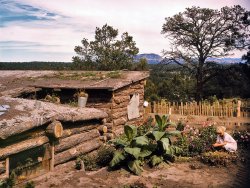
- An O.K. Store: 194x
- ... the courthouse," so this is Fourth Street in Santa Rosa, New Mexico. Though this Kodachrome slide was undated, others in the set had ... Posted by Vintagetvs - 01/22/2017 - 2:58pm -
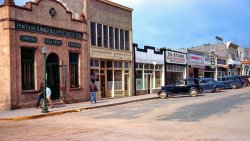
- Get Busy: 1942
- ... boxcars at gunpoint, shipped out of town and dumped in the New Mexico desert.
[Bisbee! Cafe Roka! Will you adopt me? - Dave]
... Posted by Dave - 07/16/2014 - 10:47am -
![Get Busy: 1942 December 1942. "Armed guard at a copper smelter of the Phelps-Dodge Mining Company at Morenci, Arizona. This plant is supplying great quantities of the copper so vital in our war effort." Oh, and: Merry Christmas! Photo by Fritz Henle for the Office of War Information. View full size.
CarbineNo awkwardly long barrel for this guy; he'll let 'em get in close, and then he'll let 'em have it.
Armed Guard?I thought it was just another James Arness photo.
When I Say No LoafingI mean it!
I'd be willing to bet there aren't any copper thieves hanging around, either!
The Power of MiningHaving researched the history of Bisbee, the Southern Arizona mining town where I live, this image comes as no surprise. Up until the late 1950s, companies like Phelps Dodge pretty much ran this territory and did not take kindly to any interlopers or troublemakers. One good example would be the 1917 Bisbee Deportation, where scores of socialist mine workers (unionists) were herded into boxcars at gunpoint, shipped out of town and dumped in the New Mexico desert.
[Bisbee! Cafe Roka! Will you adopt me? - Dave]
(The Gallery, Christmas, Fritz Henle, Mining, WW2)](https://www.shorpy.com/files/images/SHORPY_8d36516u.thumbnail.jpg)
- Chapel in the Sky: 1943
- ... Spring 1943. Church at Cerros [Cerro], near Costilla, New Mexico. View full size. 4x5 Kodachrome transparency by John Collier.
... Posted by Dave - 08/01/2012 - 1:31pm -
![Chapel in the Sky: 1943 Spring 1943. Church at Cerros [Cerro], near Costilla, New Mexico. View full size. 4x5 Kodachrome transparency by John Collier.
bothThe stucture probably served both purposes....church and school.
Schoolhouse?Looks more like a church to me, with a steeple topped by a cross at the far end.
[You're absolutely correct. Thanks! I should have blown this one up. Anyone familiar with where this is? - Dave]
Cerro, NMThe actual town name is Cerro, not Cerros. It's in Taos county just south of the Colorado border.
(The Gallery, Kodachromes, John Collier, Landscapes)](https://www.shorpy.com/files/images/1a34465uu.thumbnail.jpg)
- South by Southwest: 1938
- June 1938. "Railroad tracks in Southwestern New Mexico." 4x5 nitrate negative by Dorothea Lange for the Resettlement ... Posted by Dave - 11/04/2015 - 11:22am -
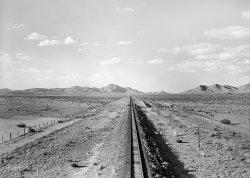
- Pie Town Barbecue: 1940
- ... Barbecue dinner at the Catron County Fair at Pie Town, New Mexico. View full size. 35mm Kodachrome transparency by Russell Lee.
... Posted by Dave - 09/08/2011 - 5:29pm -
![Pie Town Barbecue: 1940 September 1940. Barbecue dinner at the Catron County Fair at Pie Town, New Mexico. View full size. 35mm Kodachrome transparency by Russell Lee.
Kodachrome...I still find it stunning to see a photo of this vintage with such incredible color. I don't know when Kodachrome was first introduced but it must have knocked people's socks off! No wonder Paul Simon wrote that song.
[Circa 1935. Kodachrome is a transparency film (positive as opposed to negative - the image has to be projected or backlit for viewing), so was not used much for making photographic prints (snapshots), but was widely used for color separations in publishing. Before slide projectors got popular, the public's main exposure to Kodachrome was color pictures in magazines. One of the first to use it in a big way was National Geographic. - Dave]
BBQAwesome image. Everyone is just going about their business and nobody notices they are being photographed. It's like the photographer was completely invisible.
Kind of odd that there are no tables or chairs or benches anywhere. It looks very ad hoc.
[How can we tell from just one photo that there are "no tables or chairs or benches anywhere"? They're here. And here. - Dave]
(The Gallery, Pie Town, Rural America, Russell Lee)](https://www.shorpy.com/files/images/1a34115u.thumbnail.jpg)
- Laguna Coaling Station: 1943
- ... Santa Fe R.R. train stopping for coal and water at Laguna, New Mexico. March 1943. View full size. 4x5 Kodachrome transparency by ... Posted by Dave - 02/02/2008 - 1:18pm -
![Laguna Coaling Station: 1943 Santa Fe R.R. train stopping for coal and water at Laguna, New Mexico. March 1943. View full size. 4x5 Kodachrome transparency by Jack Delano.
Looks pretty like a HDRLooks pretty like a HDR image
HDR?What great picture, with snow in the desert, what's HDR stand for?
[HDR = High Dynamic Range imaging. - Dave]
(Kodachromes, Jack Delano, Landscapes, Railroads)](https://www.shorpy.com/files/images/1a34733u.thumbnail.jpg)
- War Camp: 1918
- ... when Oklahoma,(46th) was admitted to the union. Then New Mexico and Arizona, (47 & 48th) were admitted in 1912.
Victrola ... Posted by Dave - 08/14/2008 - 2:10am -
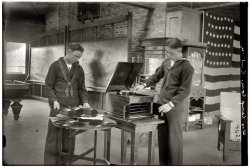
- Mixmistress Mutz: 1943
- February 1943. Moreno Valley, Colfax County, New Mexico. "George Mutz's youngest daughter helping with the cooking." Not ... Posted by Dave - 04/12/2014 - 2:20pm -
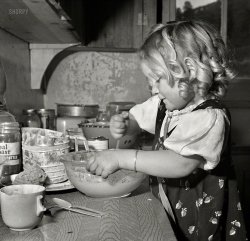
- Eastbound Freight: 1943
- ... on the Santa Fe Railroad between Amarillo and Clovis, New Mexico." Medium-format negative by Jack Delano for the Office of War ... Posted by Dave - 06/13/2015 - 11:21am -
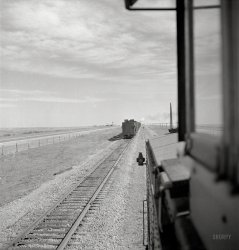
- Two Tribes: 1925
- ... Miss Meleta Chavez. Office of Congressman John Morrow of New Mexico." National Photo Company Collection glass negative. View full ... Posted by Dave - 09/21/2011 - 4:35pm -
![Two Tribes: 1925 November 12, 1925. Washington, D.C. "John Ayers, Chief of Weeminuche tribe of Ute, and Miss Meleta Chavez. Office of Congressman John Morrow of New Mexico." National Photo Company Collection glass negative. View full size.
As my father used to say:Jeez, look at the canal boats on that one.
A study in contrastNote the parallel contrast between the weathered, world-worn condition of their shoes and faces. Satin vs. leathery. Nice shot.
PityI would love to have seen this in color. I'll bet his blanket (shawl, poncho, etc.) was fantastic!
What is the white object in her hand?What is the white object in her hand?
[The furry hide of Objectus albinus. - Dave]
(The Gallery, D.C., Natl Photo)](https://www.shorpy.com/files/images/SHORPY_32076u.thumbnail.jpg)
- Pie Town BBQ: 1940
- ... and his children eating barbeque at the Pie Town, New Mexico Fair." Kodachrome transparency by Russell Lee. View full size. ... Posted by Dave - 09/07/2011 - 5:17pm -
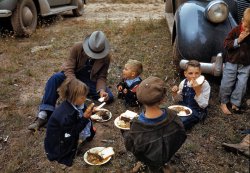
- Broadcast: 1943
- ... from his parish house broadcasting station in Questa, New Mexico. Photograph by John Collier, 1943. View full size.
re: Gear ... Posted by Ken - 09/08/2011 - 1:25pm -
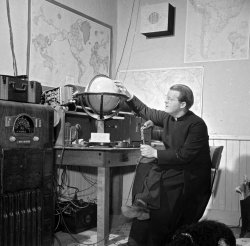
- Death's Door: 1940
- July 1940. "Entrance to the cemetery at Penasco, New Mexico." Medium format acetate negative by Russell Lee for the Farm ... Posted by Dave - 04/28/2020 - 12:32pm -
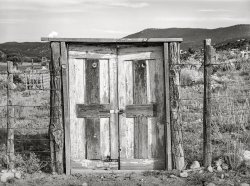
- In-Boxes: 1940
- April 1940. "Mailboxes in Catron County, New Mexico." View full size. Medium format safety negative by Russell Lee ... Posted by Dave - 09/05/2012 - 4:13pm -
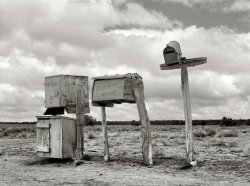
- Grunge Band: 1940
- ... "Farmer, his wife, and brother in close harmony. Pie Town, New Mexico." Nitty, Gritty and Pretty. Medium format negative by Russell Lee ... Posted by Dave - 07/31/2018 - 11:26am -
![Grunge Band: 1940 June 1940. "Farmer, his wife, and brother in close harmony. Pie Town, New Mexico." Nitty, Gritty and Pretty. Medium format negative by Russell Lee for the Farm Security Administration. View full size.
This land is your land --Woody Guthrie would so enjoy this photo. I wish we could hear it.
Music makingI really love the old photos of people making their own music at home. I kind of wish that was a more common thing in today's world!
This land is your land --I can see Woody Guthrie sitting down and singing along.
Pie TownShorpy has taken us here before. I see there's still no laundromat.
[These people didn't have indoor plumbing or electricity, either. - Dave]
(The Gallery, Music, Pie Town, Russell Lee)](https://www.shorpy.com/files/images/SHORPY-8b25295a.thumbnail.jpg)
- Long Train Going: 1943
- ... Santa Fe Railroad between Amarillo, Texas, and Clovis, New Mexico." One of hundreds of photos documenting Jack Delano's trip from ... Posted by Dave - 03/20/2013 - 1:46pm -
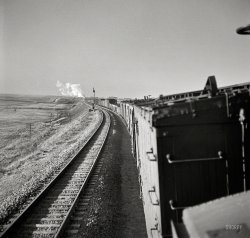
- Kirk Douglas: 1916-2020
- ... chair, on set during the filming of Ace in the Hole, New Mexico." 35mm color transparency by Charles and Ray Eames. View full ... Posted by Dave - 02/05/2020 - 8:17pm -
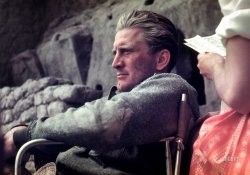
- Forbes Field: 1910
- ... of the U.S. In 1912, with the admission of Arizona and New Mexico, it was time to upgrade to a new 48-star flag.
Flag at half ... Posted by Dave - 11/10/2018 - 10:00am -
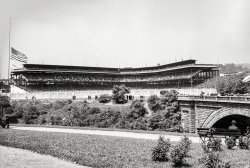
- Westbound Freight: 1943
- ... Fe R.R. westbound freight stopping for water at Melrose, New Mexico. View full size. Kodachrome transparency by Jack Delano. This is ... Posted by Dave - 08/05/2012 - 9:30am -
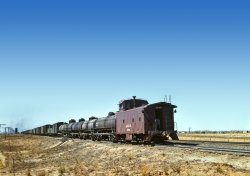
- Troop Train: 1943
- March 1943. "Grants, New Mexico. Passing a troop train stopping for coal and water on the Atchison, ... Posted by Dave - 06/17/2014 - 6:55am -
